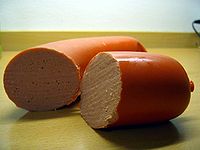Falukorv

Falukorv /ˈfɑːluˈkɔːrv/ is a Swedish sausage (korv in Swedish) made of a grated mixture of smoked pork and beef or veal with potato starch flour, onion, salt and mild spices. Falukorv is a cooked sausage, so it can be eaten without any further preparation. Some Swedes use it as a sandwich ingredient, much like ham or turkey.
History
The history of Falukorv reaches back to the Falun copper mine during the 16th and 17th century, where ox hide was used for ropes and some of the meat remaining after slaughter was salted and smoked and used for sausages. The sausage was based on the Lyoner sausage; the recipe, in which the meat is smoked and salted, was probably brought to the region by Germans working in the mine. [citation needed]
The tradition of preparing the meat in this way was revitalised in the late 19th century by the butcher Anders Olsson, whose initiative led to the development of the modern Falukorv, which uses a mixture of pork and beef or veal. A popular sausage, Falukorv has TSG status. According to EU guidelines, restrictions apply to what may be labeled "Falukorv" since 2001.[1] Only potato flour may be used as a binding agent, and the amount of meat may not fall short of 40%.
Typical falukorv meals
- Sliced and fried with boiled, fried, or mashed potato
- Sliced and fried with elbow macaroni
- Sliced and fried, served with baked Swedish brown beans and fried egg
- Gratinated whole, partially sliced, in the oven with cheese and mustard, often with slices of onion or apple tucked in between the slices, accompanied by roasted or mashed potatoes.
- Substitute for beef in Beef Stroganoff (then called Korv stroganoff)
See also
References
- ^ "Falukorv". DOOR. Europa. Retrieved 15 December 2014.

